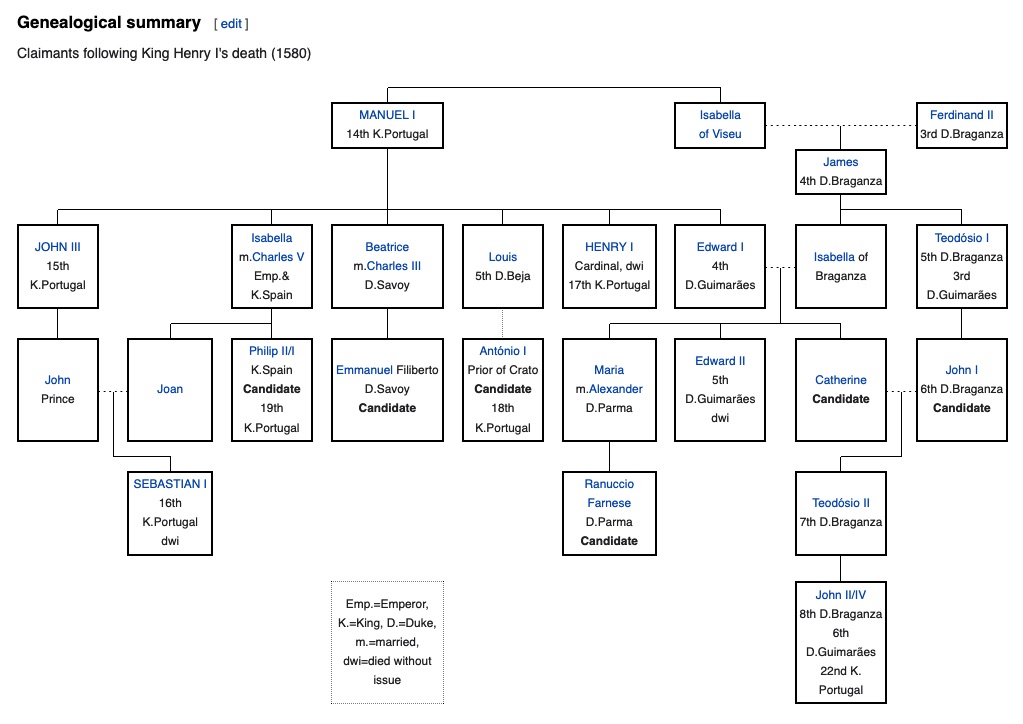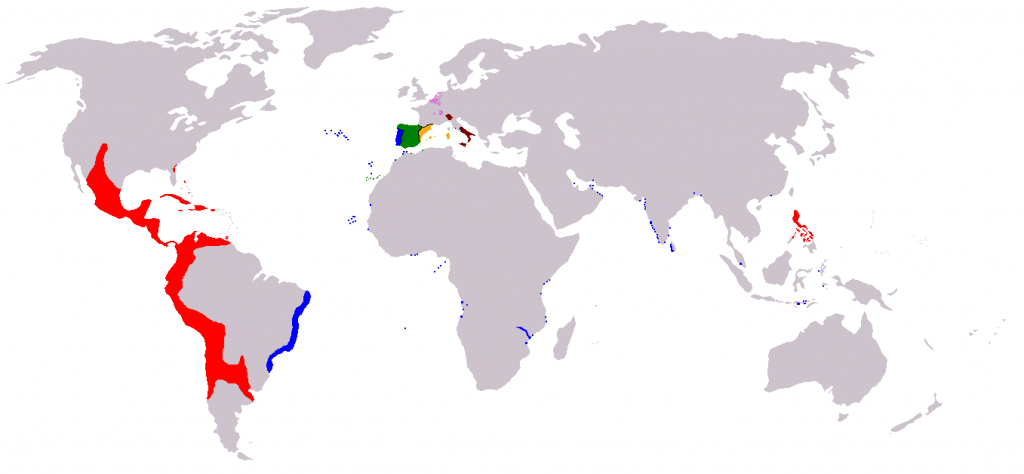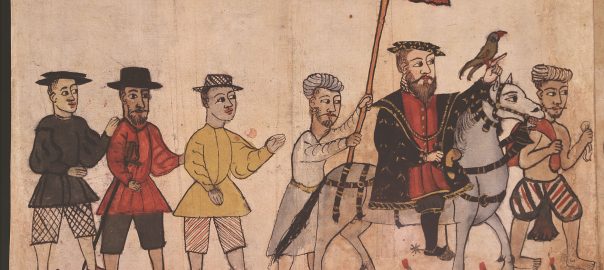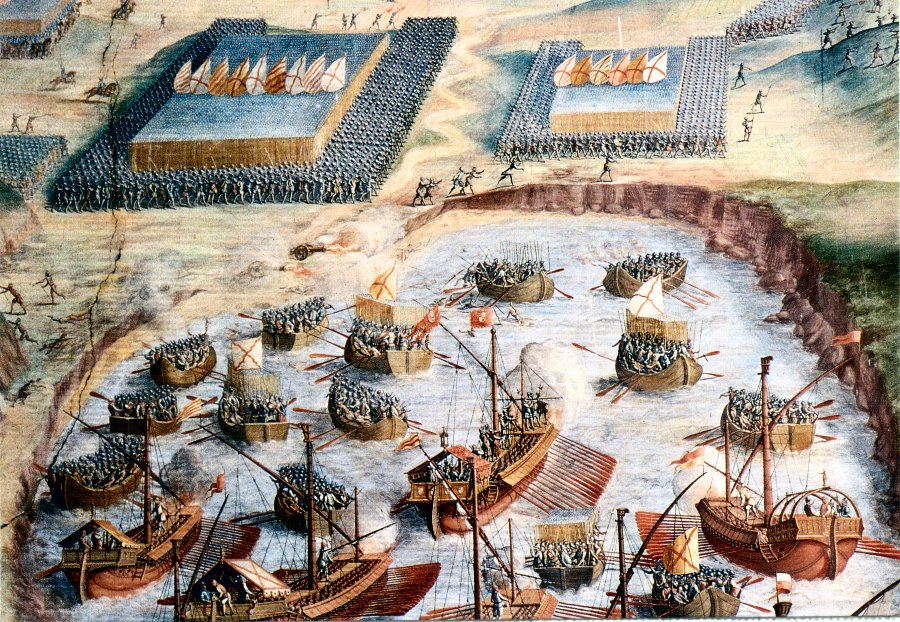The main development of world-historical impact in 1580 CE was the eruption of Portugal’s succession crisis. Before we look at that, here were a couple of other non-trivial developments:
- England signed a commercial treaty with the Ottoman Empire.
- Francis Drake returned to Plymouth after his circumnavigation.
- Jesuit missionaries arrived at the court of the Mughal emperor, Akbar. I wish I had more time to write about this, since the Jesuits were part of the way in which the Portuguese tried to infiltrate and control developments in the Indian Ocean, which the Mughals had recently reached, at the east and the west. The Portuguese strength in the Arabian Sea was particularly bothersome for the Mughals. You can read more about this here. (The image above is a 16th century painting of a Portuguese nobleman traveling in India from the Códice Casanatense.)
Also, of course in 1580 the Spanish conquistadors were still conquistadoring. E.g., one of them founded the settler-city of Buenos Aires in 1580.
On, to the main event:
Portugal’s succession crisis erupts
So, two years ago, we heard about the extremely impetuous decision the young Portuguese king, Sebastian, had taken to launch a big offensive against the Saadi ruler in Morocco… and how disastrous it turned out to be, with the Portuguese losing not only their king but almost most of their nobility, while many thousands of Portuguese soldiers were captured and taken into slavery. So Great-Uncle Henry, a cardinal, was next in line and he took over the badly battered Portuguese throne.
Henry, it turned out, had used his time as a prince of the Catholic church to bring the Jesuits to Portugal, “to employ them in the colonial empire.” Now, suddenly, age 66, he was king. His first thought was to try to leave the priesthood so he could marry and beget an heir. But the Pope did not want to antagonize Spain’s King Philip and wouldn’t let him do that.
When he died in January 1580, he hadn’t even formed a regency council to look after the country after his death.
There were numerous claimants to the throne. You can see the whole list here. And here, from this page on WP, is the whole family tree:

The first to make a definitive move was Dom António, Prior of Crato, who had spent his whole life in Portugal. (He was a claimant through a bastard line, being an illegitimate grandchild through his father Prince Louis. Also, if he was a Prior, I’m not sure how him being a monarch could ensure stable successions further along?) On July 24, 1580, he proclaimed himself King of Portugal and of the Algarves, which was followed by popular acclamation in several locations of the country.
His proclamation did not stand for long. Philip of Spain had been mustering what looked like a powerful amphibious force of some 40,000 men, led by Fernando Álvarez de Toledo, Duke of Alba. For his part, António did not have much of an army to call on, since the Portuguese Army was still in shambles after Al-Qasr al-Kbir. The two forces met and fought at Alcântara, a little west of Lisbon, on August 25. The battle ended in a decisive victory for Alba. Two days later, he captured Lisbon.
In early 1581, António fled to France and thence to the Azores. But he was defeated at sea by what was now a combined Spanish-Portuguese navy in two sea battles in the Azores region in mid-1582. He briefly attempted to rule Portugal from Terceira Island, in the Azores, where he even minted coins. (In 1589, António would make an attempt on Lisbon supported by English forces under the command of Francis Drake and John Norreys. But when the attempt failed to gain popular support, he abandoned it.)
Meantime, in 1581 King Philip II of Spain was recognized as King Philip I of Portugal and of the Algarves by the Portuguese Cortes of Tomar. Spain and Portugal would remain united in a personal union of the crowns (remaining formally independent and with autonomous administrations) for the next 60 years. This period is called the Iberian Union.
Geopolitical consequences
As we have seen,until 1580, the two power centers in Lisbon and Madrid (or earlier, Seville) had been pursuing their own own policies of imperial growth all around the world largely in parallel with each other for nearly 90 years by 1580. The Treaties of Tordesillas (1494) and Zaragoza (1529) had almost cleanly carved up the whole world between their imperial projects, reducing the friction between those two ventures, though within the theater of the European heartland they did apparently feel more free to stick pins into each other. (For example, Portugal had had a long-ish relationship with Spain’s big competitors in England.)
Anyway, now these two imperial projects were to be run as one, more or less. It’s important to understand, though, that “Spain” itself was still not ruled as a single, centralized polity; indeed, the various parts of the Spanish/Habsburg Empire were administered through a series of Councils, of which Castile and Aragon– the two progenitors of the “Spanish” monarchy that had come about through the marriage of Ferdinand and Isabella in 1469– still each had their own. The other Councils, pre-1581, ruled over, respectively, Italy, Flanders, and “the Indies”– that is, all of Spain’s overseas possessions in the Americas and the West and East Indies.
So in 1581, Philip merely added another Council to the list, this one to rule over Portugal.

There’s an extremely detailed (and somewhat confusing) description here of how the new system of administration was applied in and to Portugal; but it seems Portugal retained much control over its own domestic affairs– including over its own Inquisition, lucky them!
Regarding the administration of the Portuguese Empire during the Union period, this page on English-WP provides several key details. It tells us that, “At Tomar, Philip promised to keep the empires legally distinct, leaving the administration of the Portuguese Empire to Portuguese nationals, with a Viceroy of Portugal in Lisbon seeing to his interests. Philip even had the capital moved to Lisbon for a two-year period (1581–83) due to it being the most important city in the Iberian peninsula… “
Also, this:
The Tordesillas boundary between Spanish and Portuguese control in South America was then increasingly ignored by the Portuguese, who pressed beyond it into the heart of Brazil, allowing them to expand the territory to the west. Exploratory missions were carried out both ordered by the government, the “entradas” (entries), and by private initiative, the “bandeiras” (flags), by the “bandeirantes”. These expeditions lasted for years venturing into unmapped regions, initially to capture natives and force them into slavery, and later focusing on finding gold, silver and diamond mines…
Spanish imperial trade networks now were opened to Portuguese merchants, which was particularly lucrative for Portuguese slave traders who could now sell slaves in Spanish America at a higher price than could be fetched in Brazil. In addition to this newly acquired access to the Spanish asientos, the Portuguese were able to solve their bullion shortage issues with access to the production of the silver mining in Peru and Mexico.
And over in East Asia, meanwhile, “[Spanish] Manila was also incorporated into the [Portuguese] Macau-Nagasaki trading network, allowing Macanese of Portuguese descent to act as trading agents for Philippine Spaniards and use Spanish silver from the Americas in trade with China… “
The legacies of Sebastian’s ill-considered military adventure in Morocco meanwhile also continued in other ways– namely in the lasting effects of the loss of Portuguese military leadership and military expertise that was inflicted there. (Or maybe Portugal’s empire was badly over-extended by 1568, anyway?) Anyway, in the years of the Iberian Union, Portugal’s overseas outposts would come under increasing pressure from the armed navies of Europe’s slowly rising Protestant power-centers, England and the Netherlands, as the years ahead will show…


